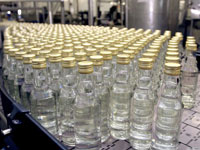Sober Soviet Society Could Not Exist in Soviet Reality
Twenty five years ago, on May 7, 1985, the party and government played yet another dirty trick on the Soviet people. The trick was named “Decree on measures of fighting drunkenness and alcoholism.“

At first, people were not too afraid. They first thought it will be the usual way – they will slightly raise the price for vodka and conduct some meetings. Yet, the issue took a serious turn and as early as in 1985 the production of vodka was reduced twofold and the number of liquor stores decreased five-fold.
There were good reasons for such decisive actions. In 1984, the average annual consumption of alcohol per person in Russia was approximately 15 liters, and in 20 regions it fluctuated near the mark of 30 liters of pure spirit.
Without doubt, the Soviet government had a lot to do with people becoming alcoholics. The budget gained nearly 50 billion rubles a year from selling alcoholic beverages. Yet, the losses from alcohol consumption (poor attendance, illnesses, traumas, defective products) amounted to over 175 billion. In 1984, the country had nearly 4.5 million registered alcoholics. Statistics for deaths from vodka and surrogates in the USSR was secret information, but, according to academician Uglov, it was close to 900 thousand deaths a year. Within the first six months of its existence, the legislation reduced the level of mortality. In 1985, 100,000 people fewer died in the USSR than in 1984. In 1987, 2.5 million people were born, and 1.53 million died.
In addition to the official approval, the government’s efforts to fight alcoholism at first were supported by the majority of Soviet people. Thousands of wives and children saw their husbands and fathers sober for the first time in years. “Drunken money” stayed in the families. It seemed that everything was wonderful. But as always, the devil was in the details.
While the party activists were happy to report about the creation of more “sobriety zones,” moonshine production in a virtual sober paradise has taken over all levels of society. In 1987 alone, more than 500,000 people were charged with moonshine brewing.
Some provincial cities displayed announcements: “Cheap cologne will be sold starting at 2pm. One item per customer.” Trade in the country side was nearly frozen since vodka accounted for over half of its volumes.
In the late 1987 - early 1988, polls revealed that 90% of population was not supportive of anti-alcohol measures. Even women were disappointed – the same women who, prior to the enactment of the law, had to wait for their husbands at a factory gate to manage to get their husbands’ salaries before they take off to the nearest wine store. Yes, now their husbands brought their money home. But who said they lost their desire to drink? During Soviet times, for many people vodka was the major, if not the only, way to put up with the Soviet reality. Perestroika failed partially because the overabundance of people’s energy had no outlet and was not mitigated by alcohol. Sober society did not want to have the government they had and chose another one who complied with their wishes. In 1993-1994 the level of alcohol consumption per person a year raised to 25 liters. This level remains high now, although it lowered to 14-18 liters. At the moment, there are 250 types of vodka available in Russia.
Arguments and Facts
Subscribe to Pravda.Ru Telegram channel, Facebook, RSS!


